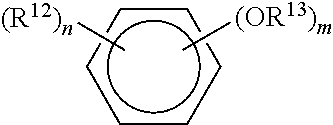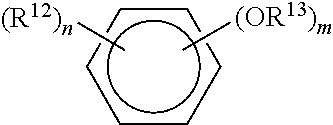Cationic antiseptic compositions and methods of use
a technology of compositions and antiseptics, applied in the field of dermatology, can solve the problems of multiple problems, increased risk of blood stream infections, and increased risk of patients, and achieve the effects of reducing or eliminating bacterial colonization, reducing or eliminating clinical signs of infection
- Summary
- Abstract
- Description
- Claims
- Application Information
AI Technical Summary
Benefits of technology
Problems solved by technology
Method used
Image
Examples
examples
[0296]
TABLE 1GLOSSARY of COMPONENTSAcronymTrade nameDescriptionSourceAddressAC 540ethylene-acrylic acidAllied-SignalMorristown,copolymerNJ2-phenoxyethanol2-phenoxyethanolAldrichMilwaukee,WIEmulsifying80 / 20 IOA / MPEGPrepared asSt. Paul, MNpolymer GG(25% polymer in IPP)described below*Polymer QQ40 / 40 / 20Prepared asSt. Paul, MNSMA / IOA / M90Gdescribed below*(25% polymer in IPP)DOSSAerosol OT-75docusate sodiumAmericanW. Patterson,CyanmidNJArlamol EPPG-15 stearyl etherUniqemaPatterson, NJbenzalkoniumbenzalkonium chlorideAldrichMilwaukee,chlorideWIbenzethoniumbenzethonium chlorideAldrichMilwaukee,chlorideWICarbowax 400Polyethyleneglycol 400DOW / UnionDanbury, CTCarbideCarowax 1450Higher MW PEG, e.gDOW / UnionDanbury, CT1450CarbideCentroflex FLecithinCentral SoyaFort Wayne,INCeraphyl 494isocetyl stearateISPLombard, ILCerasynt GMSglyceryl stearateISPLombard, ILCHGchlorhexidinechlorhexidineMedChemGalena, ILgluconate 18.9%gluconate 18.9%LaboratoriesPHMBCosmocil CQ 20%Polyhexamethylene-ICI AmericasWilm...
examples 1-9
[0301]Antimicrobial compositions of 125 grams were prepared using the components shown in Tables 2a-2b. For examples 1-6, the antiseptic component: Silver Zeolite, phospholipid CDM, Irgasan DP300, benzethonium chloride, or benzalkonium chloride was combined with Pluronic P-65 and glycerin in a first glass container and heated to 70° C. in an oven. Carbowax 1450 was heated to melting in a separate container then added to the first container along with the remaining components, swirled by hand to mix and then reheated to 70° C. in the oven. The composition was removed from the oven allowed to cool to approximately 40° C., while mixing on rollers, then transferred into jars and sealed. Examples 7-8, which contained PHMB, and example 9, which contained CHG, were prepared as described above with the exception that there was no initial heating required and these antiseptics were added after all other components were combined.
[0302]Examples 1-9 comprised hydrophilic vehicles containing a m...
example 10
[0303]An antimicrobial composition of 250 grams was prepared using the components shown in Table 2b. Carbowax 1450 was preheated to melting (approximately 65° C.), in an oven, in a glass container. All other components, except silver nitrate, were combined with the Carbowax 1450 and swirled by hand to mix. The composition was allowed to cool to approximately 50° C. and then the silver nitrate was added. The solution was allowed to further cool to approximately 40° C., then transferred to storage jars protected from light.
PUM
 Login to View More
Login to View More Abstract
Description
Claims
Application Information
 Login to View More
Login to View More - R&D
- Intellectual Property
- Life Sciences
- Materials
- Tech Scout
- Unparalleled Data Quality
- Higher Quality Content
- 60% Fewer Hallucinations
Browse by: Latest US Patents, China's latest patents, Technical Efficacy Thesaurus, Application Domain, Technology Topic, Popular Technical Reports.
© 2025 PatSnap. All rights reserved.Legal|Privacy policy|Modern Slavery Act Transparency Statement|Sitemap|About US| Contact US: help@patsnap.com



